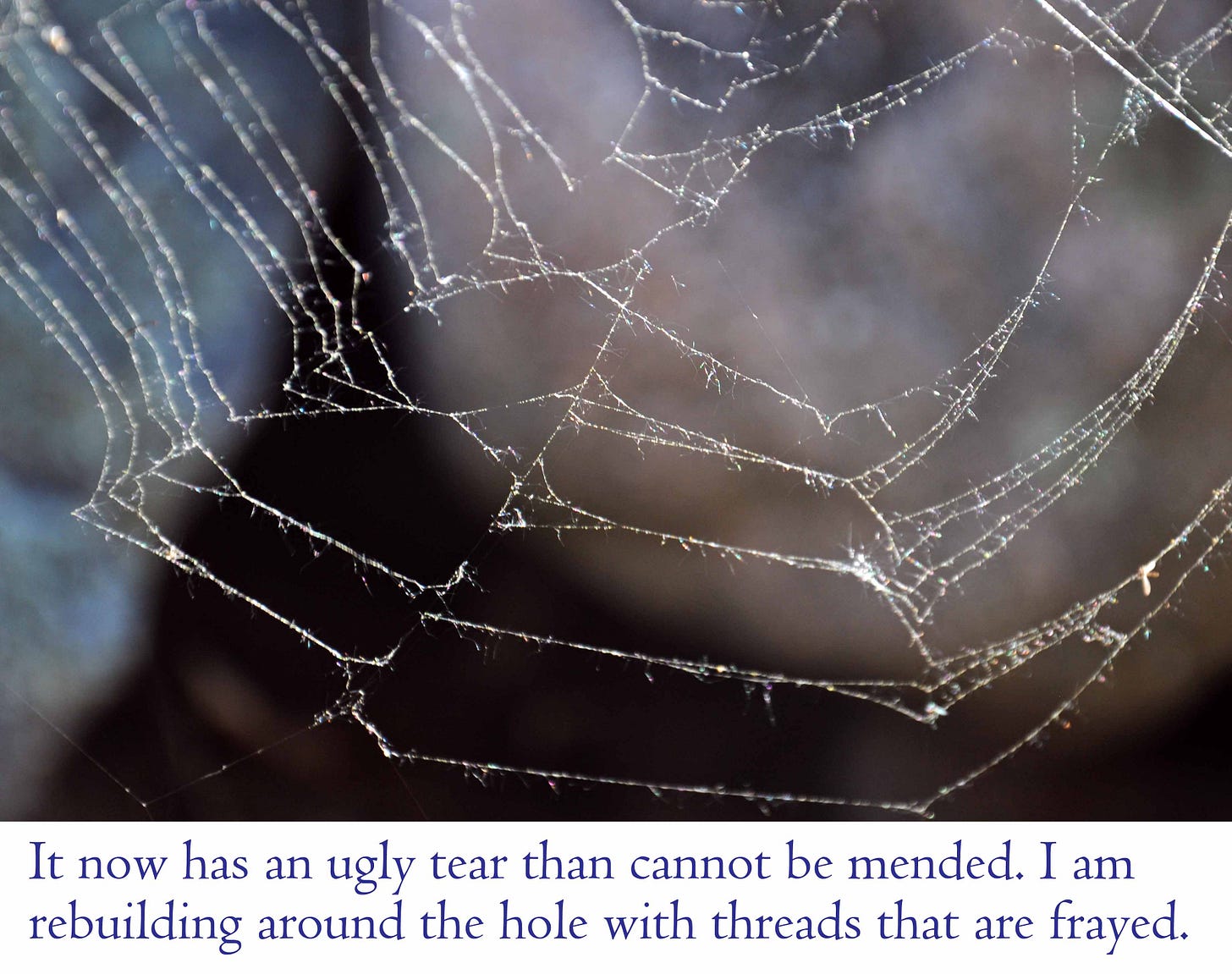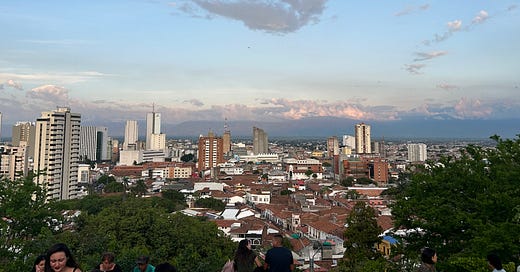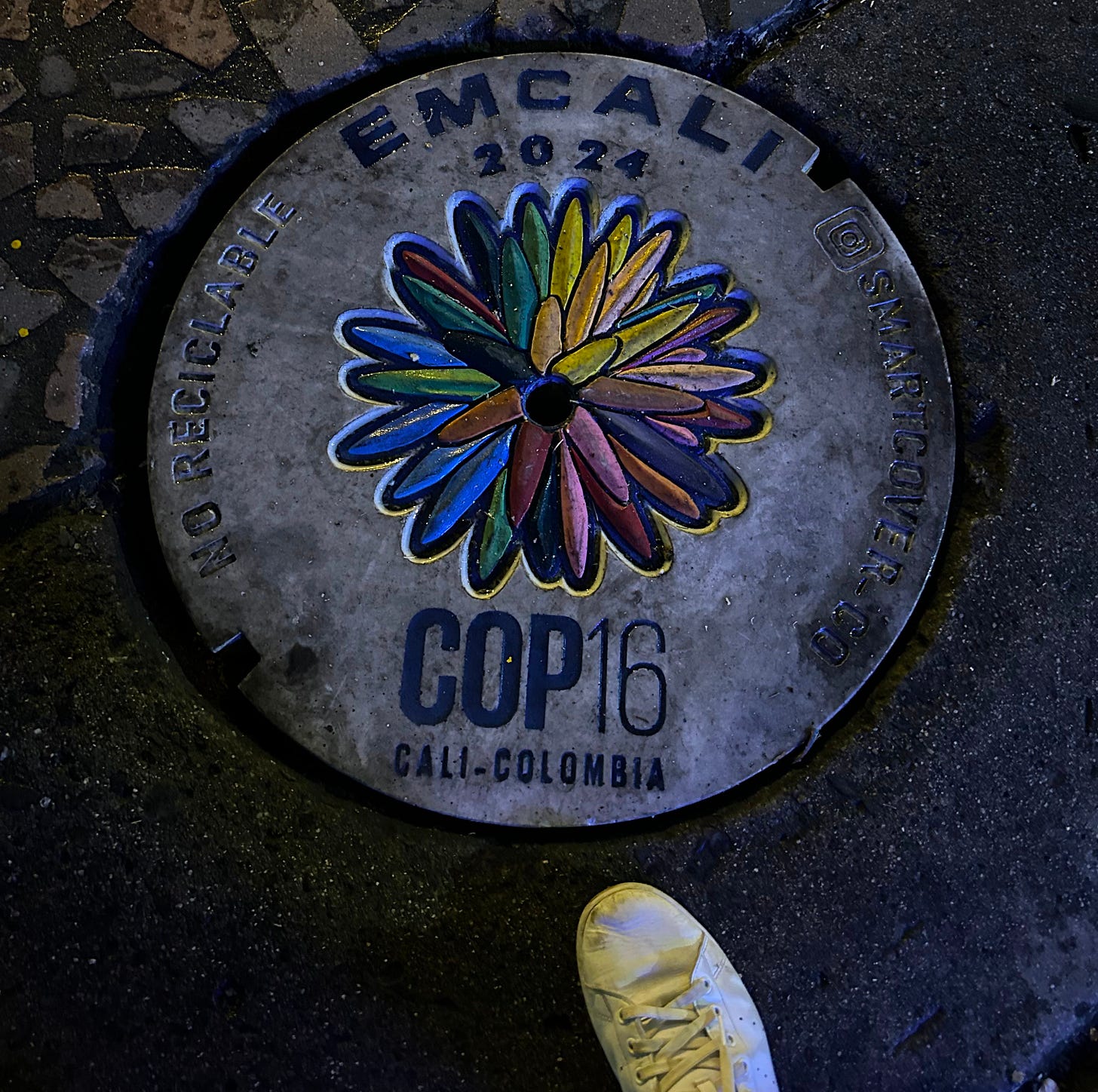Hello everyone! Have you voted yet? Do you have a plan? Are you registered? Do you know where to go? If you’re confused and need help, check out Vote.org. Now onto the piece.
The beauty of and peril of biodiversity
As I said in my last Substack post, (which you should def check out)
I'm reporting from Cali, Colombia. Nestled in the Colombian Pacific and tucked neatly between the mountains lies this magical city currently on display to the entire world. Don't worry, I won't spend this whole time talking about how much I love the place, but I will say that if you want to learn Salsa and see birds and butterflies all about, this might be the place for you.
I'm not in Cali just to visit, but rather to experience and report on a pivotal moment in the fight against worldwide environmental disaster. While I have dedicated the last few years of my life to studying climate change action, an equally as important crisis has unfolded--the extinction of millions of species of animals and plants across the world.
To be frank, I never gave the "green naturey" environmental movement much thought because I found it to be an incredibly white, upper-class space in the U.S. where people talk about their second homes in the Adirondacks. And while in the U.S. this is an issue that has historically captured the attention of rich environmentalists, biodiversity loss has drastic consequences for all of us.
For the world's farmers (who depend on pollination and natural pest control)
the world's medical industry (which depends on new breakthroughs from natural plants)
and most importantly, the millions of Indigenous people who have depended on and protected the world's richest rainforests, ocean habitats, mangroves, moors, and natural habitats that make Earth beautiful.
And so why should you care? There are different ways that I’ve grappled with.
ENTRANCEMENT- I could use the David Attenborough1 approach and emphasize that we must have empathy for the living creatures around us for their immense beauty. Save the whales! The Pandas!
ANGER and RESPONSIBILITY- I prefer the method that has shaped my thinking--the pure injustness of it all. Biodiversity is not just about protecting cute pandas.
Biodiversity projection is about protecting and respecting the millions of people and thousands of cultures that remind Earth of our richness as a species and are under the most threat from the extractive practices consuming our Earth.
Of course it's important to respect life for just that, being alive. And I could go into a whole critique of our human egocentrism and talk about the Anthropocene. But putting that aside, I ask myself a simple question.
If we're selfish, can we at least be selfish for the future of humanity?
Why is biodiversity important?
Biodiversity is the building block of complex life on Earth. It is the abundance of species and birdcalls in the fall forest. It's the competitive and cooperative food chain in our coral reefs that sustains 25% of marine life.2 It's what makes crops grow (pollinators, pest-controlling animals), what keeps water clean (purifying water from its source to the tap), what makes life...beautiful and heterogenous.
I like to think of biodiversity as an intricately weaved basket with a bunch of connections will resist force, because there are so many points of strengths in the interdependency.

But when we lose biodiversity, we lose this strength. We lose the threads of resiliency that protect life when bad things happen--floods, droughts, fires, land encroachment, plagues, etc. And in a rapidly warming, flooding, drying, burning, logging, diseased world due to climate change, bad things are happening.

This year, the Amazon Rainforest has recorded its worst drought since 1950.3 But what is less understood is that the Amazon creates its own microbiome. It creates its own rain and regenerates its own nutrients, which allows it to be so rich. With deforestation from cattle grazing, illegal mining, and ilegal crop cultivation, we are killing the species (threads) that make the Amazon so resilient.
There have always been droughts. But because of climate change, this drought is worse. And because we are killing biodiversity, the Amazon rainforest is starting to dry faster and convert into grasslands. And with its death dies the richness of plant-based medicines, Indigenous cultures, carbon capture from trees, and the natural resources that sustain regions surrounding the Amazon.
This is happening everywhere, not just the Amazon. And the consequences are nothing less than devastating. So we have to do something. And this is where COP16 , or the Council of Parties, comes in.
Why is COP16 in Cali, Colombia, and why is that important?
Hopefully, at this point (for those still reading), you recognize the importance of biodiversity in the world, not just for its beauty, but rather the necessity for human survival. In addition, the example of the Amazon Rainforest demonstrates that climate change and biodiversity are intricately tied, both in their destruction and protection.
The next question I would ask is, Why is it important that COP 16 is in Cali, Colombia?
Colombia is the second most biodiverse country on Earth, behind Brazil, and the most biodiverse country per square km2.4 It's a country with immense riches from the Amazon rainforest to the Pacific tropical forest to the various mountain ranges that carve this country into distinct cultural and environmental masterpieces. When I got off the plane, I was faced with billboards of greenery and oceans selling Cali's natural beauty. After all, any international conference is as much a tourism ad as a convention for altruistic cooperation.
But more importantly, Colombia's very relation to its environment makes the conference much more interesting than if it was in the Global North. This is a country home to dozens of Indigenous and Afro-descendent populations that preserve the cultural diversity of the country.5
It carries a violent revolutionary past of persistent conflict between armed groups and the government, resulting in the dispossession of millions of hectares of land from campesinos (peasants) and ethnic populations. In the pursuit of "development" proposed by the national government and the hundreds of multinational corporations that frequent the country, many of its rivers, mountaintops, and pristine ecosystems have been contaminated by the extraction of natural resources like fossil fuels and minerals.
In almost of these cases, biodiversity loss doesn’t mean the loss of your computer screensaver--it's the loss of water, food, and culture that have sustained life for millions.
In essence, Colombia characterizes the complicated discourse of environmentalism that we rarely discuss in the "developed world". It's about us. About our lives. About our futures.
What actually happens in COP
With this context, it's important to understand what's actually being discussed at COP16. In 2022, 196 countries signed on to the Kunming-Montreal Global Biodiversity Framework (most notably with the exception of the United States). This is the equivalent of the Paris Agreement signed to keep climate change and global warming to under 1.5 degrees Celsius.
As the Framework notes in its introduction,
"An average of around 25 per cent of species in assessed animal and plant groups are threatened, suggesting that around 1 million species already face extinction, many within decades, unless action is taken to reduce the intensity of drivers of biodiversity loss. Without such action, there will be a further acceleration in the global rate of species extinction, which is already at least tens to hundreds of times higher than it has averaged over the past 10 million years.
The biosphere, upon which humanity as a whole depends, is being altered to an unparalleled degree across all spatial scales. Biodiversity – the diversity within species, between species and of ecosystems – is declining faster than at any time in human history. Nature can be conserved, restored and used sustainably while other global societal goals are simultaneously met through urgent and concerted efforts fostering transformative change.
The direct drivers of change in nature with the largest global impact have been (starting with those with the most impact) changes in land and sea use, direct exploitation of organisms, climate change, pollution and invasion of alien species. Those five direct drivers result from an array of underlying causes, the indirect drivers of change, which are, in turn, underpinned by social values and behaviours (…)The rate of change in the direct and indirect drivers differs among regions and countries."
This framework has 23 rules, but the key points are simple.
Halt Biodiversity Loss, like actually. Protecting the millions of species that are at risk of extinction from...well...going extinct.
Protect 30% of Earth's land and ocean cover. Set up protected areas so that extractive industries don't continue to compromise these ecosystems.
Restore degraded ecosystems. Replant, reinvest in what we've broken.
Integrate climate change into the conversation. Promote solutions that store carbon and protect biodiversity.
Involve indigenous peoples. Don't just make this a top-down framework that doesn't account for the local realities of how people live.
Figure out how to make things change. Create governance structures, regional agreements, and official routes of actions.
One of the main reasons for this COP16 is to check in with countries in how they've implemented this framework into their national framework. But it's also about the universal tool being leveraged to accomplish these goals--finance.
It's important that COP16 is in Colombia because its precisely the Global South that holds much of the world's biodiversity and is requesting the lion's share of funding. And, conversely, it's the Global North that has much of the historical responsibility for exploiting these natural resources unsustainably and must work to offer accessible funds for biodiversity protection in countries such as Colombia.
So, as I digest COP in its full beauty and entirety, one of the main things I'm looking at is the confluence between Global South knowledge and necessity and Global North responsibility and institutional capacity. Where do they meet, if they even meet at all?
And, where are we going?
For people that read this and want to do something, there’s plenty of small actions you can take. Join your local environmental club chapter of a Sierra Club, the Nature Conservancy, or even better, the smaller organizations working on local biodiversity efforts where you live. Google small actions to improve biodiversity loss. Maybe stop eating so much beef. There’s always a way.
Look forward for a post-COP analysis coming up next.

Sincerely,
Rishab
To be fair, I love David Attenborough and his calls to conservation and climate change action. This is more of a joke than a substantive comment.
Source: Interactive Country Fiches






